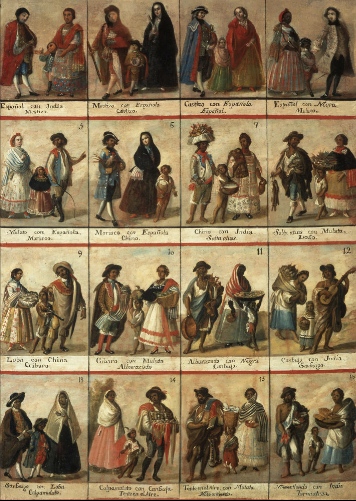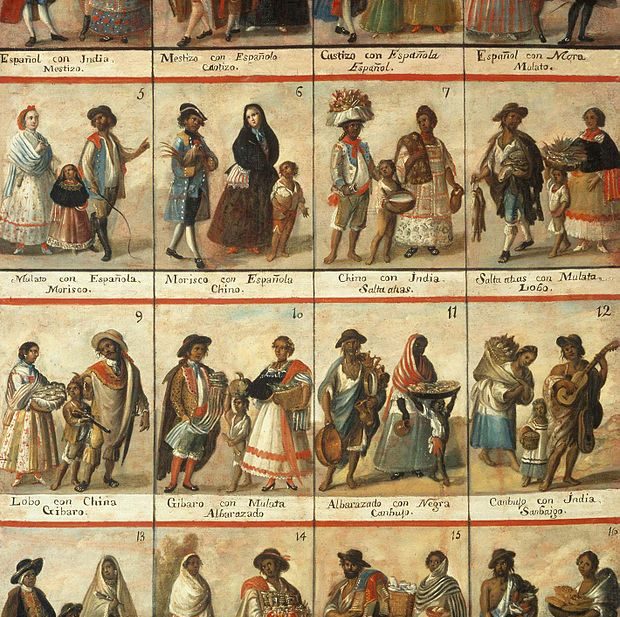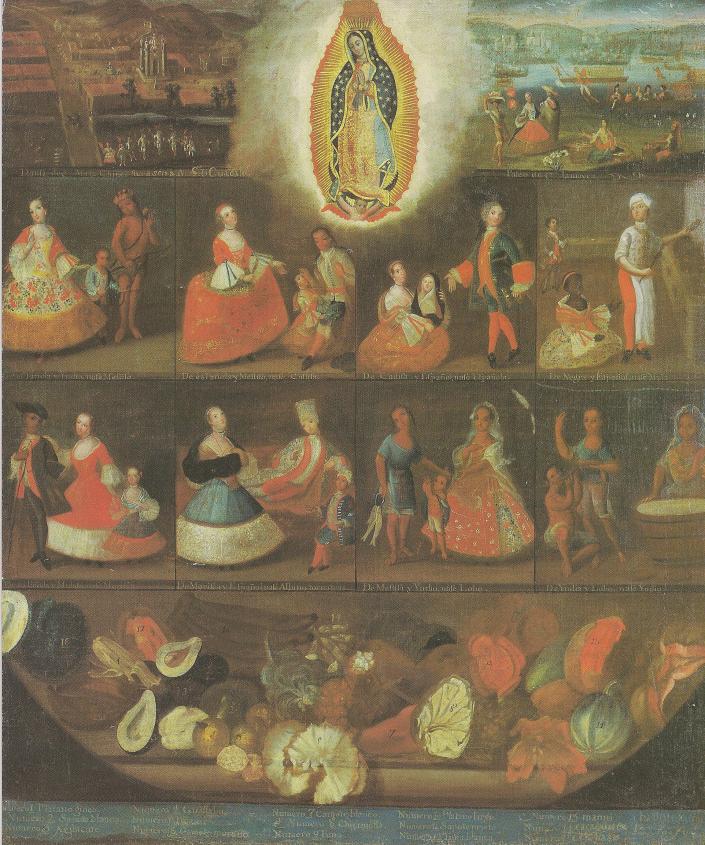Images of Race in Eighteenth-Century Mexico. Casta painting categorized its subjects bya race gender and social hierarchyb religion and.
The social composition of Mexico during the eighteenth century was based on the existence of.

. Las castas Painting containing complete set of 16 casta combinations. Called casta paintings in English this new genre took as its subject the colonial issue of race raza racial intermarriage and their offspring. Casta painting categorized its subjects by race gender and social hierarchy.
Almost always painted in a series of approximately sixteen canvases they depict a mother father and child each of whom represents a different category within the sislema de castas or racial lineages. Desire to classify the world and understand its diversity. In contrast mixtures with Blacks both by Indians and Spaniards led to a bewildering number of combinations with fanciful terms to describe them.
Between the landscapes and the still life eight small images placed in two rows of four dominate the panel. Race Affluence and Sartorial Expression in 17th Century Mexico. Start with Indian and Spanish and end with Indian savage family.
As with all geographies this book is formed as a journey with an itinerary that guides the viewerreader through both visual and textual material in an effort to examine the historical and social topography reproduced through cuadros de casta or casta paintings a secular genre of painting that depicts Spaniards Indians Africans and their mixed-blooded. Mainly European audience or in Spanish creole elite homes. Indicating racial mixture names such as mestizo mulata morisca and lobo.
Race and Identity in Colonial Latin America ed. Spanish Indian and American 18th century. Casta is an Iberian word existing in Spanish Portuguese and other Iberian languages since the Middle Ages meaning lineage breed or race to describe as a whole the mixed-race people which appeared in the post-Conquest period.
Joining those initial essentialized. Asked Jul 9 2016 in Art Culture by Halter_Soni. Fisher and Matthew D.
Casta paintings were presented most commonly in a series of sixteen individual canvases or a single canvas divided into sixteen compartments. Each figure is labeled with a caste name. The greatest artist of romantic protest was the Spanish painter Francisco Goya 17461828 whose paintings and drawings depicted the senseless brutality of war and oppression.
Casta painting categorized its subjects by _____. Casta paintings used labels and visual details such as different skin tones dress occupations and settings to distinguish ethnicity and to signal economic and class divisions. Twinam Ann Purchasing Whiteness in Imperial Subjects.
Identity and Social Stratification in Colonial Mexico Ilona Katzew New York University This article first appeared in the catalog for the exhibition New World Orders. Casta Painting. Written By Syddie Lou.
The series usually depict a man woman and child arranged according to a hierarchies of race and status the latter increasingly represented by occupation as well as dress by the mid-eighteenth century. Paintings of racial mixtures. Yale University Press 2004.
An 18th century socio-racial classification system used in the Spanish American colonies. Casta Painting 18th century oil on canvas 148 x 104 cm Museo Nacional del Virreinato Mexico Though it is a striking oil painting saturated with color detail and artful renditions Las Castas was not created merely to be viewed as. Fisher and Matthew D.
Almost always painted in a. Asked Jan 14 2019 in Art Culture by usc0993. Spaniards in Mexico had long since added new racial terminology ofespanoles12 European whites negros Africans and indios Indians which were legal categories in the colonial system.
Duke University Press 2009 141-165. When he painted this work circa 1750 casta painting was well established as a genre of Mexican art. Casta Painting A type of painting that was common in Mexico in the 18th century that depicts a racially mixed family consisting of the two parents of different races and their child.
Yale University Press 2004. Casta Painting and Colonial Latin America organized by the Americas Society Art Gallery Sept. Posted on June 15 2013 by Roberta Estes.
Called casta paintings in English this new genre took as its subject the colonial issue of race raza racial intermarriage and their offspring. Present New Spain to. Negro Mulatto and Morisco were labels found in colonial-era documentation but Albino and Torna atrás exist only as fairly standard categories in casta paintings.
Race and Identity in Colonial Latin America ed. The text beneath reads De Español y Indio. Typically as in this example from Mexico casta paintings comprise sixteen scenes that register through the presentation of family groups the progressive dilution of pure Spanish Indian and African blood.
Each numbered and identified in a key. Twinam Ann Purchasing Whiteness in Imperial Subjects. Depicts a mother a father and a child.
The European conquest of Latin America beginning in the late 15th century was initially executed by male soldiers and sailors from the Iberian Peninsula. Casta painting categorized its subjects by. The element that linked power to visibility in the design of Jeremy Benthams A General Idea of a Penitentiary Panopticon was its _______.
All groups are equal later ones put certain races about others. These images did not reflect reality so much as represent stereotypes arranged along a biased hierarchical scale. In the upper left corner a well-dressed Spanish man extends his arms to receive his child from his indigenous mate.
The element that linked power to visibility in the design of Jeremy Benthams A General Idea of a Penitentiary Panopticon was its circular shape. Images of Race in Eighteenth-Century Mexico.

Casta Paintings Spaniard And Indian Produce A Mestizo Article Khan Academy

Casta Paintings Spaniard And Indian Produce A Mestizo Article Khan Academy

Casta Paintings Spaniard And Indian Produce A Mestizo Article Khan Academy





0 comments
Post a Comment